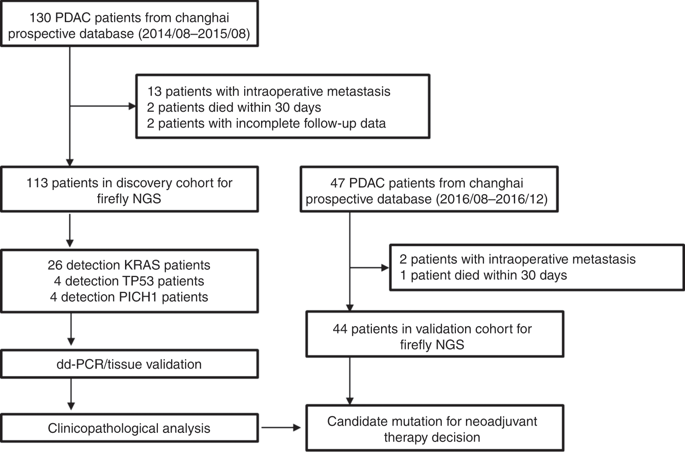当前位置:
X-MOL 学术
›
Br. J. Cancer
›
论文详情
Our official English website, www.x-mol.net, welcomes your feedback! (Note: you will need to create a separate account there.)
Preoperative detection of KRAS G12D mutation in ctDNA is a powerful predictor for early recurrence of resectable PDAC patients.
British Journal of Cancer ( IF 8.8 ) Pub Date : 2020-01-23 , DOI: 10.1038/s41416-019-0704-2 Shiwei Guo 1 , Xiaohan Shi 1 , Jing Shen 1 , Suizhi Gao 1 , Huan Wang 1 , Shuo Shen 1 , Yaqi Pan 1 , Bo Li 1 , Xiongfei Xu 1 , Zhuo Shao 1 , Gang Jin 1
British Journal of Cancer ( IF 8.8 ) Pub Date : 2020-01-23 , DOI: 10.1038/s41416-019-0704-2 Shiwei Guo 1 , Xiaohan Shi 1 , Jing Shen 1 , Suizhi Gao 1 , Huan Wang 1 , Shuo Shen 1 , Yaqi Pan 1 , Bo Li 1 , Xiongfei Xu 1 , Zhuo Shao 1 , Gang Jin 1
Affiliation

|
BACKGROUND
About 25-37% of resectable pancreatic ductal adenocarcinoma (PDAC) had a great chance of early recurrence after radical resection, which is mainly due to preoperative micrometastasis. We herein demonstrated the profiles of ctDNA in resectable PDAC and use of ctDNA to identify patients with potential micrometastasis.
METHODS
A total of 113 and 44 resectable PDACs were enrolled in discovery and validation cohorts, separately. A panel containing 50 genes was used to screen ctDNA by an NGS-based assessment with high specificity.
RESULTS
In the discovery cohort, the overall detection rate was 38.05% (43/113). Among positive ctDNA, KRAS mutation had the highest detection rate (23.01%, 26/113), while the others were <5%. Survival analysis showed that plasma KRAS mutations, especially KRAS G12D mutation, had significant association with OS and RFS of resectable PDAC. Plasma KRAS G12D mutation showed a strong correlation with early distant metastasis. In the validation cohort, survival analysis showed similar association between plasma KRAS G12D mutation and poor outcomes.
CONCLUSIONS
This study demonstrated that plasma KRAS mutations, especially KRAS G12D mutation, served as a useful predictive biomarker for prognosis of resectable PDAC. More importantly, due to high correlation with micrometastasis, preoperative detection of plasma KRAS G12D mutation helps in optimising surgical selection of resectable PDAC.
中文翻译:

术前检测 ctDNA 中的 KRAS G12D 突变是可切除 PDAC 患者早期复发的有力预测指标。
背景技术约25-37%的可切除胰腺导管腺癌(PDAC)在根治性切除后早期复发的可能性很大,这主要是由于术前微转移所致。我们在此展示了 ctDNA 在可切除 PDAC 中的概况,并使用 ctDNA 来识别具有潜在微转移的患者。方法 共有 113 例和 44 例可切除 PDAC 分别被纳入发现和验证队列。使用包含 50 个基因的 panel,通过基于 NGS 的高特异性评估来筛选 ctDNA。结果 在发现队列中,总体检出率为 38.05% (43/113)。ctDNA阳性中,KRAS突变检出率最高(23.01%,26/113),其他均<5%。生存分析表明,血浆 KRAS 突变,尤其是 KRAS G12D 突变,与可切除 PDAC 的 OS 和 RFS 显着相关。血浆 KRAS G12D 突变显示与早期远处转移有很强的相关性。在验证队列中,生存分析显示血浆 KRAS G12D 突变与不良结果之间存在类似关联。结论 本研究表明,血浆 KRAS 突变,尤其是 KRAS G12D 突变,可作为可切除 PDAC 预后的有用预测生物标志物。更重要的是,由于与微转移高度相关,术前检测血浆KRAS G12D突变有助于优化可切除PDAC的手术选择。结论 本研究表明,血浆 KRAS 突变,尤其是 KRAS G12D 突变,可作为可切除 PDAC 预后的有用预测生物标志物。更重要的是,由于与微转移高度相关,术前检测血浆KRAS G12D突变有助于优化可切除PDAC的手术选择。结论 本研究表明,血浆 KRAS 突变,尤其是 KRAS G12D 突变,可作为可切除 PDAC 预后的有用预测生物标志物。更重要的是,由于与微转移高度相关,术前检测血浆KRAS G12D突变有助于优化可切除PDAC的手术选择。
更新日期:2020-01-23
中文翻译:

术前检测 ctDNA 中的 KRAS G12D 突变是可切除 PDAC 患者早期复发的有力预测指标。
背景技术约25-37%的可切除胰腺导管腺癌(PDAC)在根治性切除后早期复发的可能性很大,这主要是由于术前微转移所致。我们在此展示了 ctDNA 在可切除 PDAC 中的概况,并使用 ctDNA 来识别具有潜在微转移的患者。方法 共有 113 例和 44 例可切除 PDAC 分别被纳入发现和验证队列。使用包含 50 个基因的 panel,通过基于 NGS 的高特异性评估来筛选 ctDNA。结果 在发现队列中,总体检出率为 38.05% (43/113)。ctDNA阳性中,KRAS突变检出率最高(23.01%,26/113),其他均<5%。生存分析表明,血浆 KRAS 突变,尤其是 KRAS G12D 突变,与可切除 PDAC 的 OS 和 RFS 显着相关。血浆 KRAS G12D 突变显示与早期远处转移有很强的相关性。在验证队列中,生存分析显示血浆 KRAS G12D 突变与不良结果之间存在类似关联。结论 本研究表明,血浆 KRAS 突变,尤其是 KRAS G12D 突变,可作为可切除 PDAC 预后的有用预测生物标志物。更重要的是,由于与微转移高度相关,术前检测血浆KRAS G12D突变有助于优化可切除PDAC的手术选择。结论 本研究表明,血浆 KRAS 突变,尤其是 KRAS G12D 突变,可作为可切除 PDAC 预后的有用预测生物标志物。更重要的是,由于与微转移高度相关,术前检测血浆KRAS G12D突变有助于优化可切除PDAC的手术选择。结论 本研究表明,血浆 KRAS 突变,尤其是 KRAS G12D 突变,可作为可切除 PDAC 预后的有用预测生物标志物。更重要的是,由于与微转移高度相关,术前检测血浆KRAS G12D突变有助于优化可切除PDAC的手术选择。


























 京公网安备 11010802027423号
京公网安备 11010802027423号